Redefining the standards of industrial gas leak inspections
When every leak matters for safety and reliability, Distran ultrasound cameras provide the confidence that your inspections are thorough and accurate.
Distran handheld ultrasound imaging camera detects gas leaks instantly by identifying the specific sounds emitted by pressurized gas leaks, thanks to 124 ultrasound microphones, contact-free, meters away, even in the loudest and most complex industrial environments. Ultra Pro cameras reconstruct the position of the leaks by overlaying acoustic imaging onto the wide-angle optical image in real-time.
Distran cameras are built for teams who need speed, precision, and proof.
Leverage Distran’s advanced algorithms to uncover smaller leaks hidden by background noise, and be confident your inspection has left no leak undetected.
Capture photos and videos of leaks, with leak rate quantified and geotagged data, ready for instant reporting. Generate reports in a few clicks, either using Audalytics, Distran’s reporting software, or your own system via API integration.
Detects leaks of any gas type


Working distance from
Typical: 1-8 meters
From 30 centimeters to > 200 meters
From 1 foot to > 220 yards

Down to
0.15 L/h
or 0.005 SCFH for a 1.5 bar (22 PSI) gas leak detected at 30 cm (1 ft) distance in a quiet environment

Extended View
Optical field of view > 150°
Acoustic field of view: 180°

Lightweight device
Single-handed, 1.5 kg
or 3.3 lb
Ultra Pro Series – Ultrasonic leak imaging for high-reliability inspections
Redefining the standards of industrial gas leak inspections

When every leak matters for safety and reliability, Distran ultrasound cameras provide the confidence that your inspections are thorough and accurate.
Distran handheld ultrasound imaging camera detects gas leaks instantly by identifying the specific sounds emitted by pressurized gas leaks, thanks to 124 ultrasound microphones, contact-free, meters away, even in the loudest and most complex industrial environments. Ultra Pro cameras reconstruct the position of the leaks by overlaying acoustic imaging onto the wide-angle optical image in real-time. It’s built for teams who need speed, precision, and proof.
Leverage Distran’s advanced algorithms to uncover smaller leaks hidden by background noise, and be confident your inspection has left no leak undetected.
Capture photos and videos of leaks, with leak rate quantified and geotagged data, ready for instant reporting. Generate reports in a few clicks, either using Audalytics, Distran’s reporting software, or your own system via API integration.
Detects leaks of any gas type:

Working distance from
Typical: 1-8 meters
From 30 centimeters to > 200 meters
From 1 foot to > 220 yards

Down to
0.15 L/h
or 0.005 SCFH for a 1.5 bar (22 PSI) gas leak detected at 30 cm (1 ft) distance in a quiet environment

Extended View
Optical field of view > 150°
Acoustic field of view: 180°

Lightweight device
Single-handed, 1.5 kg
or 3.3 lb
DeepRange:
Extended sensitivity to reveal smaller leaks in noisy environments
In noisy industrial plants, small gas leaks can easily go undetected, often masked by louder equipment or lost in background noise. Yet small leak doesn’t mean non-critical; these undetected leaks still affect safety and reliability.
DeepRange empowers inspectors to see beyond the noise. This algorithm intelligently separates and enhances faint acoustic signals in real-time, revealing small leaks that other systems may overlook.
The result:
- Fewer blind spots: detect leaks even beside loud compressors, vents, or bigger leaks.
- Greater impact: protect people, prevent downtime, and reduce emissions.
When safety and uptime are non-negotiable, such as in Oil & Gas, Chemical, and Power Generation facilities, DeepRange ensures you find every leak that matters, in a single pass.
DeepRange:
Extended sensitivity to reveal smaller leaks in noisy environments
In noisy industrial plants, small gas leaks can easily go undetected, often masked by louder equipment or lost in background noise. Yet small leak doesn’t mean non-critical; these undetected leaks still affect safety and reliability.
DeepRange empowers inspectors to see beyond the noise. This algorithm intelligently separates and enhances faint acoustic signals in real-time, revealing small leaks that other systems may overlook.
The result:
- Fewer blind spots: detect leaks even beside loud compressors, vents, or bigger leaks.
- Greater impact: protect people, prevent downtime, and reduce emissions.
When safety and uptime are non-negotiable, such as in Oil & Gas, Chemical, and Power Generation facilities, DeepRange ensures you find every leak that matters, in a single pass.
Same situation, 2 different algorithms. How does DeepRange enhance the sensitivity of Ultra Pro Max?
Machinery noise
↓ detected without DeepRange
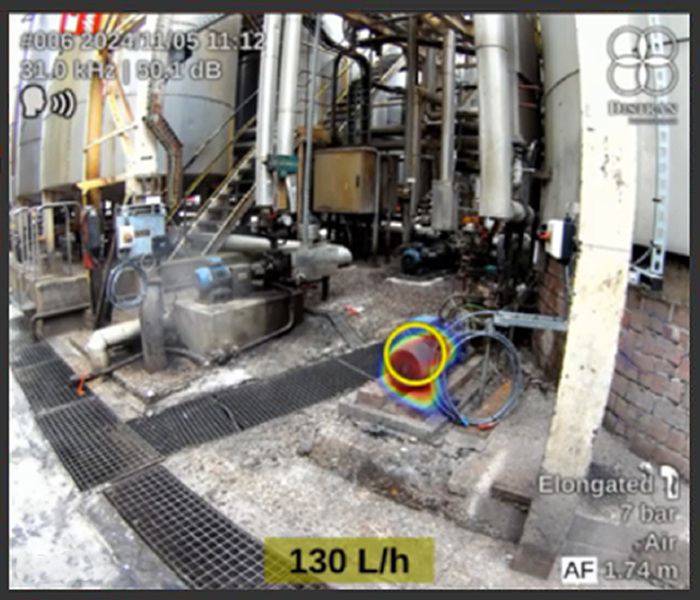
Actual leak
↓ detected with DeepRange

Detection Confidence Level (DCL):
Makes leak inspections consistent across shifts and trustworthy for managers
In complex facilities, from refineries to power plants, managers responsible for gas leak inspections often face the same challenge: How can I be sure the job is truly complete?
Distran’s Detection Confidence Level (DCL) removes that uncertainty. It enables your teams to verify when an area has been fully inspected, ensuring no significant leak goes undetected.
- During an inspection, Ultra Pro Max continuously assesses the detection conditions. If conditions could compromise accuracy, the camera alerts the operator to adjust its approach in real-time.
- With DCL, inspection teams gain measurable confidence, while managers gain documented assurance that inspections are consistent, compliant, and verifiable across sites.
Whatever the asset, DCL transforms leak detection: from a routine task to evidence-backed assurance of safety, reliability, and emissions control.

Set the minimal target leak size you wish to detect, and the camera will indicate the level of confidence that it has in detecting all leaks above your target:
← In this case, you can be confident that you have detected all leaks above your target.
In this case, the camera warns the operator →
that not all leaks above the target can be detected; this suggests an adjustment to the inspection approach.
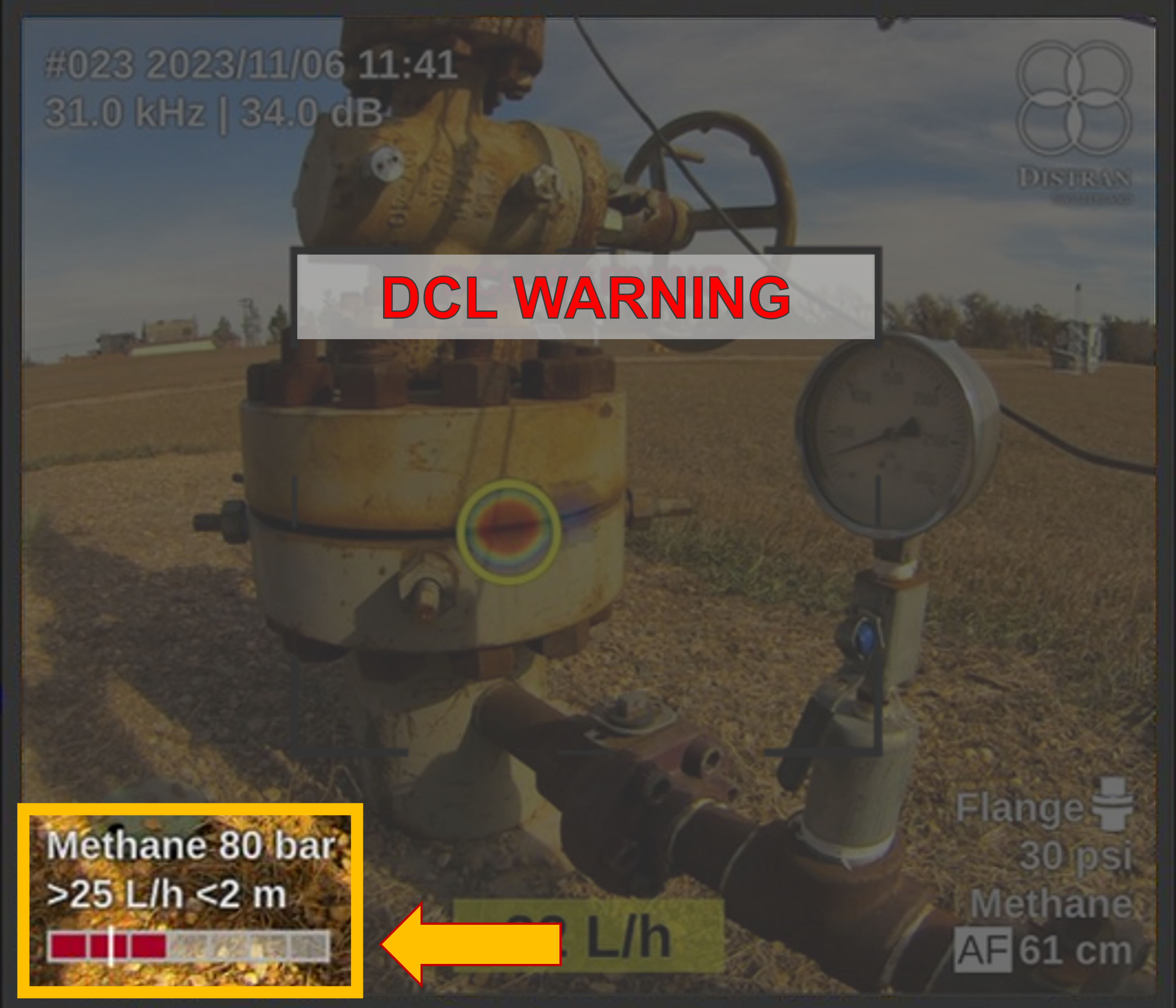
Detection Confidence Level (DCL):
Makes leak inspections consistent across shifts and trustworthy for managers
In complex facilities, from refineries to power plants, managers responsible for gas leak inspections often face the same challenge: How can I be sure the job is truly complete?
Distran’s Detection Confidence Level (DCL) removes that uncertainty. It enables your teams to verify when an area has been fully inspected, ensuring no significant leak goes undetected.
- During an inspection, Ultra Pro Max continuously assesses the detection conditions. If conditions could compromise accuracy, the camera alerts the operator to adjust its approach in real-time.
- With DCL, inspection teams gain measurable confidence, while managers gain documented assurance that inspections are consistent, compliant, and verifiable across sites.
Whatever the asset, DCL transforms leak detection: from a routine task to evidence-backed assurance of safety, reliability, and emissions control.
Set the minimal target leak size you wish to detect, and the camera will indicate the level of confidence that it has in detecting all leaks above your target:

In this case, you can be confident that you have detected all leaks above your target.

In this case, the camera warns the operator that not all leaks above the target can be detected; this suggests an adjustment to the inspection approach.
Benefits
Why choose Distran Ultra Pro Series?
DeepRange: Enhanced sensitivity in noisy areas
DeepRange unlocks greater sensitivity capabilities. It uncovers smaller leaks, even in noisy environments, saving time while reducing risks in terms of safety and compliance. (Only available in Ultra Pro Max)
Detection Confidence Level (DCL)
Ensures no significant leak is overlooked by guiding operators to meet defined inspection thresholds. (Only available in Ultra Pro Max)
10x faster than traditional methods
Classical gas detectors require the operator to thoroughly check every potential leakage point. With Acoustic Leak Imaging, detection is performed without scanning, meters away, reducing the need for scaffolding.
Quantify leak rates live
Distran devices provide leak severity and cost in real-time, through leak quantification (in L/h, g/h or SCFH) and cost calculation (yearly amount, currency of your choice) without using tripod or post processing. Classify leaks per degree of danger or cost to coordinate maintenance operations.
Reduce exposure to gases
Leaks are detected without contact with the gas, at a distance. Operators' exposure to hazardous and toxic gases is greatly reduced.
Uncover leaks in unexpected locations
As sound propagates beyond our line of sight, hidden leaks that are missed with other techniques can be detected with Acoustic Imaging. Leverage Distran cameras' 180° acoustic and >150° optical field of view to survey more ground at once.
Embedded GPS & Built-in reporting tool
Leak findings are automatically geotagged to enable mapping features, under ready-to-use reports generated in a few clicks, streamlining compliance and follow-up.
Built-in Health Center
Built-in automated diagnostics keep the device in top condition, triggering a warning if faulty, guaranteeing reliable performance for every inspection.
How to choose between Ultra Pro Lite and Ultra Pro Max?
See here the differences to select the best device for your facilities and applications:
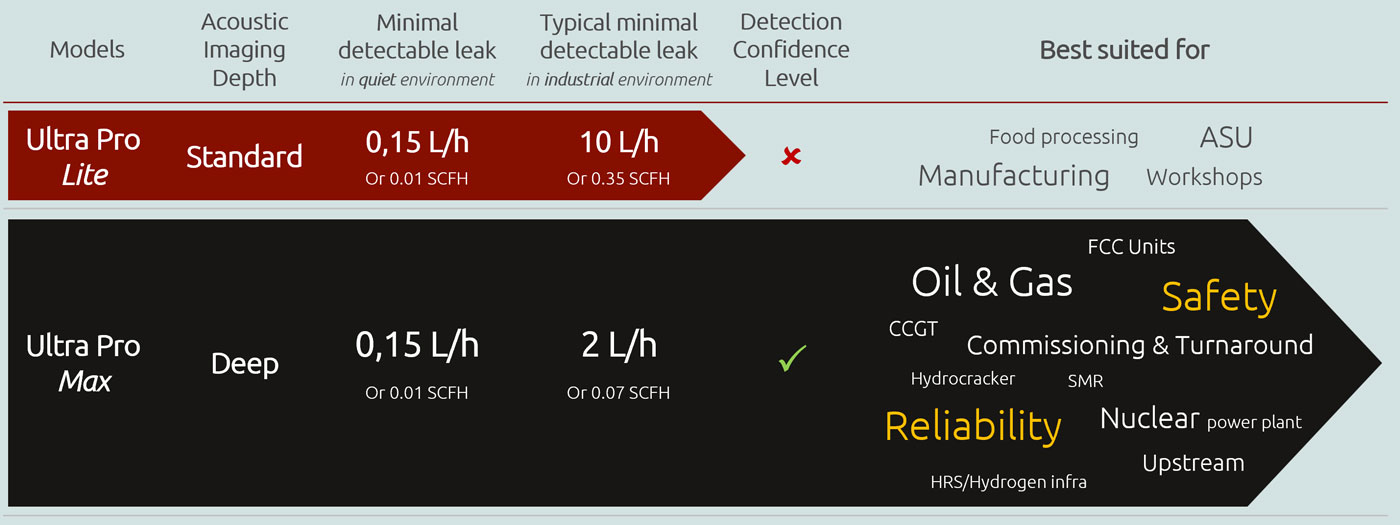
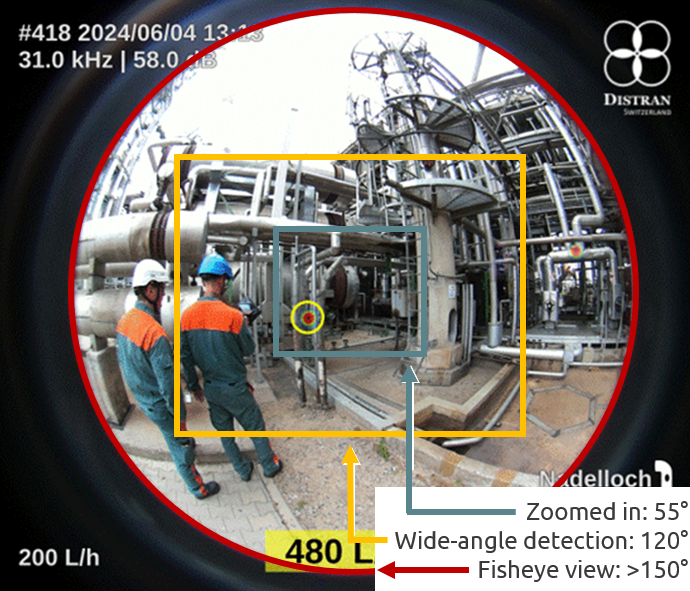
Cover more ground in less time and reduce the risk of missed leaks
Widest field of view for more efficient inspections
- Follow in-frame leak indications to uncover leakages at 180°
- Survey highly complex areas by visualizing premises at >150°
- Stay safe; inspect at a distance and get a closer look with the 4.3X optical zoom.
This wide coverage enables faster detection and significantly reduces the likelihood of overlooking leaks, especially in large or complex industrial plants, where extensive areas must be inspected quickly and thoroughly.
Expand your field of view and don’t miss leaks.
Cover more ground in less time and reduce the risk of missed leaks
Widest field of view for more efficient inspections

Expand your field of view and don’t miss leaks.
- Follow in-frame leak indications to uncover leakages at 180°
- Survey highly complex areas by visualizing premises at >150°
- Stay safe; inspect at a distance and get a closer look with the 4.3X optical zoom.
This wide coverage enables faster detection and significantly reduces the likelihood of overlooking leaks, especially in large or complex industrial plants, where extensive areas must be inspected quickly and thoroughly.
Instantly quantify leak rates to prioritize maintenance
Quantify each leak’s severity as you go
The Distran cameras detect and locate leaks, and also quantify the severity of a gas leak in real-time, without requiring a tripod or post-processing. The leak rate is displayed live (in liters per hour, grams per hour, or standard cubic feet per hour) based on the sound source’s loudness.
The cost of each leak is also displayed on the screen, eliminating the need for external tools or calculations. Input the gas type and its unit cost, and the system calculates the annual financial loss based on the measured leak rate and your selected currency.
Leverage these dual insights to classify leaks by order of danger or cost, prioritize maintenance actions, allocate resources efficiently, and support ROI-based decision-making.
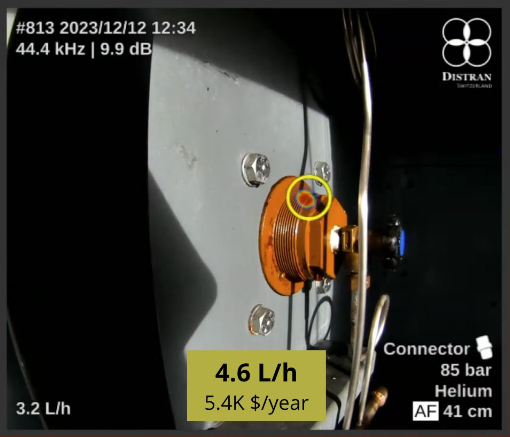
Instantly Quantify leak rates to prioritize maintenance
Quantify each leak’s severity as you go

The Distran cameras detect and locate leaks, and also quantify the severity of a gas leak in real-time, without requiring a tripod or post-processing. The leak rate is displayed live (in liters per hour, grams per hour, or standard cubic feet per hour) based on the sound source’s loudness.
The cost of each leak is also displayed on the screen, eliminating the need for external tools or calculations. Input the gas type and its unit cost, and the system calculates the annual financial loss based on the measured leak rate and your selected currency.
Leverage these dual insights to classify leaks by order of danger or cost, prioritize maintenance actions, allocate resources efficiently, and support ROI-based decision-making.
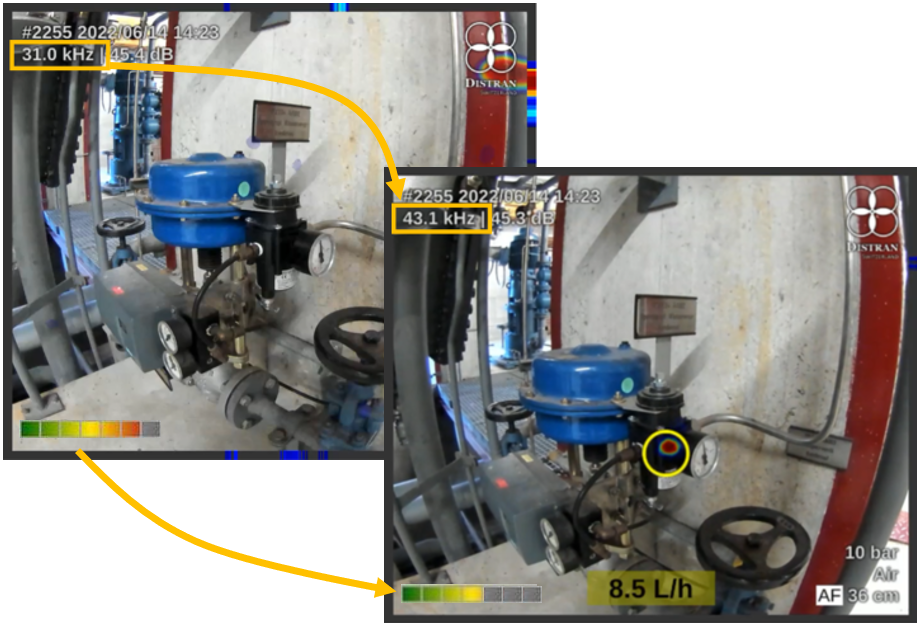
Instant feedback on background noise’s impact
Assess current detection conditions with the Ambient Sound Indicator
The Ambient Sound Indicator is a colored gauge displayed live. It provides operators with instant feedback on ambient ultrasonic noise levels, making them aware of the detection conditions.
- Green means conditions are ideal for detecting even a small leak
- Orange indicates that only larger leaks may be detectable
- Red signals high noise levels; adjustments are required to improve detection
Refer to this indicator to take immediate action to enhance detection conditions, following best practices provided in our training. In this example, the operator would have missed the leak.
Instant feedback on background noise’s impact
Assess current detection conditions with the Ambient Sound Indicator

The Ambient Sound Indicator is a colored gauge displayed live. It provides operators with instant feedback on ambient ultrasonic noise levels, making them aware of the detection conditions.
- Green means conditions are ideal for detecting even a small leak
- Orange indicates that only larger leaks may be detectable
- Red signals high noise levels; adjustments are required to improve detection
Refer to this indicator to take immediate action to enhance detection conditions, following best practices provided in our training. In this example, the operator would have missed the leak.
Generate advanced reports with mapping feature
*Cameras equipped from October 2025 onwards, depending on your needs, the GPS chip can be removed or disabled.
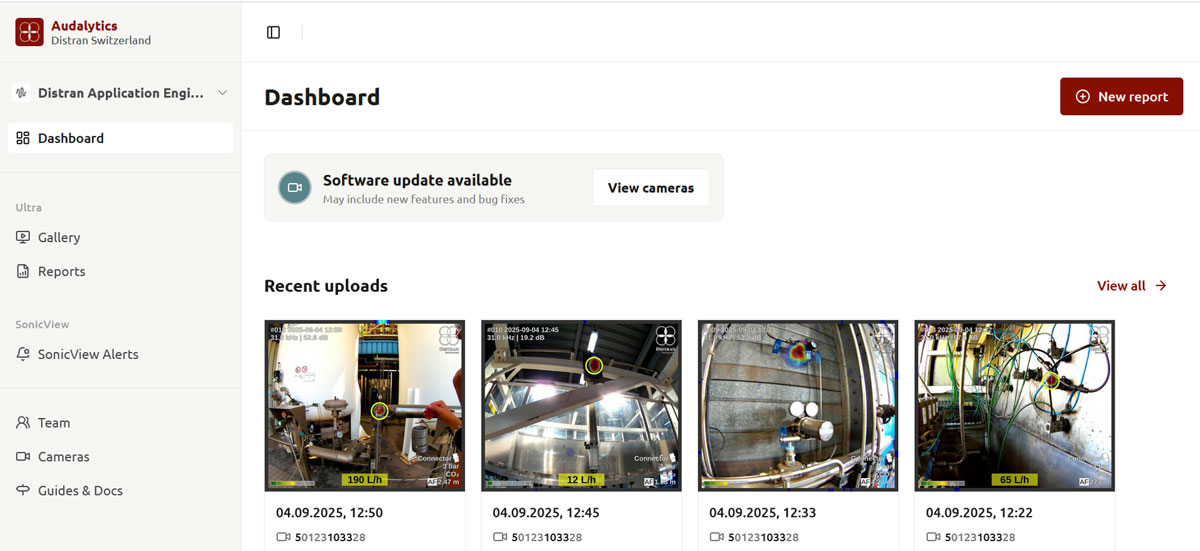

Generate advanced reports with mapping feature
*Cameras equipped from October 2025 onwards, depending on your needs, the GPS chip can be removed or disabled.


Locate partial discharges, such as corona, tracking, arcing
Pinpoint partial discharges and other electrical faults
Partial discharges such as Corona discharges, arcing and tracking happen in high-voltage systems and may lead to failures. These phenomena produce ultrasound and can be precisely localized with a Distran camera.

Locate partial discharges, such as corona, tracking, arcing
Pinpoint partial discharges and other electrical faults

Partial discharges such as Corona discharges, arcing and tracking happen in high-voltage systems and may lead to failures. These phenomena produce ultrasound and can be precisely localized with a Distran camera.
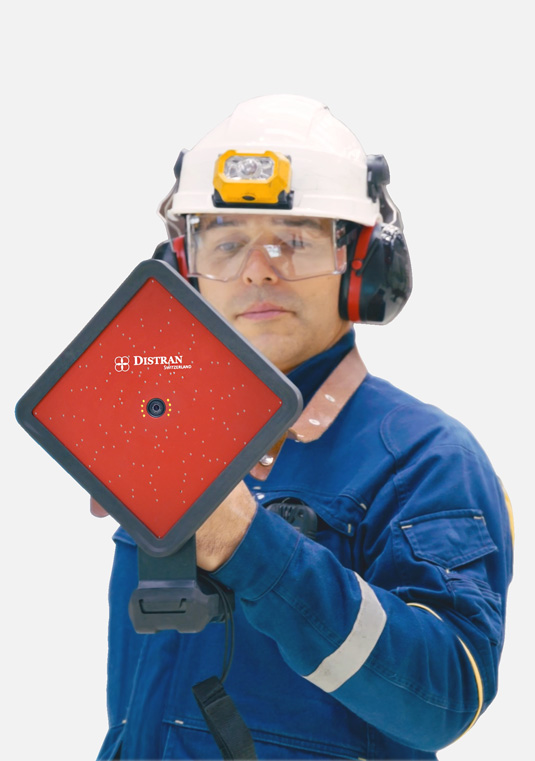
Best-in-class handling in the field
Distran’s ultrasound cameras have been developed with industry professionals, supported by commissioning and inspection experts who have performed countless industrial inspections. Weighing only 1.5 kg, including its battery, the camera is operated with a single hand, so the operator can safely inspect it, even on a staircase. The camera has also been tested for drops, designed to be robust. Its integrated LED lighting illuminates dark areas without needing a separate light source.
1.5 kg all inclusive
Single-handed, self contained
Use the device while batteries charge
Wrist and neck straps included
1400 lumens, integrated LED lighting
Robust design
Compatible with Ultra Ready
Ex-proof (ATEX, IECEx, UL HazLoc certified)
Best-in-class handling in the field
Distran’s ultrasound cameras have been developed with industry professionals, supported by commissioning and inspection experts who have performed countless industrial inspections. Weighing only 1.5 kg, including its battery, the camera is operated with a single hand, so the operator can safely inspect it, even on a staircase. The camera has also been tested for drops, designed to be robust. Its integrated LED lighting illuminates dark areas without needing a separate light source.
1.5 kg all inclusive
Single-handed, self contained
Use the device while batteries charge
Wrist and neck straps included
1400 lumens, integrated LED lighting
Robust design
Compatible with Ultra Ready
Ex-proof (ATEX, IECEx, UL HazLoc certified)

TECHNICAL DATA
Technical specifications
| Specifications | Ultra Pro Lite | Ultra Pro Max |
|---|---|---|
| Detected gases | All compressed gases incl. hydrocarbons, hydrogen, compressed air, vacuum and steam | All compressed gases incl. hydrocarbons, hydrogen, compressed air, vacuum and steam |
| Acoustic Imaging Depth | Standard | DeepRange |
| Minimal detectable leak | 0.15 L/h (for a 1.5 bar N2 leak, from 30 cm) 0.005 SCFH (for a 22 psi N2 leak, from 1 ft) | 0.15 L/h (for a 1.5 bar N2 leak, from 30 cm) 0.005 SCFH (for a 22 psi N2 leak, from 1 ft) |
| Minimum detectable leak in a typical industrial setting | 10 L/h | 0.35 SCFH | 2 L/h | 0.07 SCFH |
| Detection Confidence Level (DCL) | No | Real-time indication of the confidence in detecting all leaks exceeding the user-defined threshold |
| Angle of view | Extended View: Optical: >150° | Acoustic: 180° | Extended View: Optical: >150° | Acoustic: 180° |
| Optical zoom | Up to 4.3X | Up to 4.3X |
| Working distance | Typical: from 1 to 8 meters | from 3 to 26 feet From 30 centimeters (1 foot) to > 200 meters (> 220 yards) | Typical: from 1 to 8 meters | from 3 to 26 feet From 30 centimeters (1 foot) to > 200 meters (> 220 yards) |
| Acoustic Focus | Automatic estimation of distance to sound source | Automatic estimation of distance to sound source |
| Multiple leak detection | Automatic & simultaneous | Automatic & simultaneous |
| Leak rate Quantification | Quantification in L/h, g/h, or SCFH in real time Gas-specific models for H2, CH4, Ar, CO2, He, N2, Air | Quantification in L/h, g/h, or SCFH in real time Gas-specific models for H2, CH4, Ar, CO2, He, N2, Air |
| Leak cost estimation | Shown live in the currency of your choice, calculated as a yearly amount | Shown live in the currency of your choice, calculated as a yearly amount |
| Frequency range | 8-58 kHz, with embedded spectrogram | 8-58 kHz, with embedded spectrogram |
| Ex-Proof option | Ultra Pro X Lite: ATEX: II 3G Ex ic IIC T5 Gc; II 3D Ex ic IIIC T100°C Dc IECEx/KOSHA: Ex ic IIC T5 Gc; Ex ic IIIC T100°C Dc UL/CSA: Class I, Division 2, Groups A, B, C, D, T4 Tamb = -10°C to 40°C | Ultra Pro X Max: ATEX: II 3G Ex ic IIC T5 Gc; II 3D Ex ic IIIC T100°C Dc IECEx/KOSHA: Ex ic IIC T5 Gc; Ex ic IIIC T100°C Dc UL/CSA: Class I, Division 2, Groups A, B, C, D, T4 Tamb = -10°C to 40°C |
| IP Rating | Ultra Pro X Lite: IP54 | Ultra Pro X Max: IP54 |
| Health Center | Self-diagnostic of the microphone array and sensor processors | Self-diagnostic of the microphone array and sensor processors |
| GPS | Built-in GPS (GPS, Galileo, GLONASS), user configurable | Built-in GPS (GPS, Galileo, GLONASS), user configurable |
| Reporting system & Data export | Audalytics, included Export leak findings via Wifi or SD card Files format: JPEG and MP4 | Audalytics, included Export leak findings via Wifi or SD card Files format: JPEG and MP4 |
| Annotations of findings | Add information to leak findings: gas type, asset, PNID, etc. | Add information to leak findings: gas type, asset, PNID, etc. |
| Voice-to-text | Document findings hands-free while inspecting, transcribe into text with a click | Document findings hands-free while inspecting, transcribe into text with a click |
| API Integration | Integrate leak findings seamlessly with your own system via API | Integrate leak findings seamlessly with your own system via API |
| Weight | Single hand, 1,5 kgs | 3.3 lb | Single hand, 1,5 kgs | 3.3 lb |
| Battery life | 5 hours (2.5 h x 2 batteries included) | 5 hours (2.5 h x 2 batteries included) |
| Integrated LED lights | 1400 lumens | 1400 lumens |
| Operating temperature range | Ultra Pro Lite: -20°C to 50°C | -4°F to 122°F | Ultra Pro Max: -20°C to 50°C | -4°F to 122°F |
| Training | Onsite training led by experts, online resources available | Onsite training led by experts, online resources available |
| Certifications | EMC & RED: 2014/30/EU | 2014/53/EU | FCC 47 CFR part 15 B | ICES-003 RoHS: 2011/65/EU | WEEE: 2012/19/EU UL Safety: IEC 61010-1 | EMC & RED: 2014/30/EU | 2014/53/EU | FCC 47 CFR part 15 B | ICES-003 RoHS: 2011/65/EU | WEEE: 2012/19/EU UL Safety: IEC 61010-1 |
–
TECHNICAL DATA
Technical specifications
| Specifications | Ultra Pro Max |
|---|---|
| Detected gases | All compressed gases incl. hydrocarbons, hydrogen, compressed air, vacuum and steam |
| Acoustic Imaging Depth | DeepRange |
| Minimal detectable leak | 0.15 L/h (for a 1.5 bar N2 leak, from 30 cm) 0.005 SCFH (for a 22 psi N2 leak, from 1 ft) |
| Minimum detectable leak in a typical industrial setting | 2 L/h | 0.07 SCFH |
| Detection Confidence Level (DCL) | Real-time indication of the confidence in detecting all leaks exceeding the user-defined threshold |
| Angle of view | Extended View: Optical: >150° | Acoustic: 180° |
| Optical zoom | Up to 4.3X |
| Working distance | Typical: from 1 to 8 meters | from 3 to 26 feet From 30 centimeters (1 foot) to > 200 meters (> 220 yards) |
| Acoustic Focus | Automatic estimation of distance to sound source |
| Multiple leak detection | Automatic & simultaneous |
| Leak rate Quantification | Quantification in L/h, g/h, or SCFH in real time Gas-specific models for H2, CH4, Ar, CO2, He, N2, Air |
| Leak cost estimation | Shown live in the currency of your choice, calculated as a yearly amount |
| Frequency range | 8-58 kHz, with embedded spectrogram |
| Ex-Proof option | Ultra Pro X Max: ATEX: II 3G Ex ic IIC T5 Gc; II 3D Ex ic IIIC T100°C Dc IECEx/KOSHA: Ex ic IIC T5 Gc; Ex ic IIIC T100°C Dc UL/CSA: Class I, Division 2, Groups A, B, C, D, T4 Tamb = -10°C to 40°C |
| IP Rating | Ultra Pro X Max: IP54 |
| Health Center | Self-diagnostic of the microphone array and sensor processors |
| GPS | Built-in GPS (GPS, Galileo, GLONASS), user configurable |
| Reporting system & Data export | Audalytics, included Export leak findings via Wifi or SD card Files format: JPEG and MP4 |
| Annotations of findings | Add information to leak findings: gas type, asset, PNID, etc. |
| Voice-to-text | Document findings hands-free while inspecting, transcribe into text with a click |
| API Integration | Integrate leak findings seamlessly with your own system via API |
| Weight | Single hand, 1,5 kgs | 3.3 lb |
| Battery life | 5 hours (2.5 h x 2 batteries included) |
| Integrated LED lights | 1400 lumens |
| Operating temperature range | Ultra Pro Max: -20°C to 50°C | -4°F to 122°F |
| Training | Onsite training led by experts, online resources available |
| Certifications | EMC & RED: 2014/30/EU | 2014/53/EU | FCC 47 CFR part 15 B | ICES-003 RoHS: 2011/65/EU | WEEE: 2012/19/EU UL Safety: IEC 61010-1 |
–
Contact us
Frequently Asked Questions
What distance can a leak be detected?
Depending on the flow rate of the leak, from 30 centimeters (1 feet) to 50-100 meters (150-300 feet). Large leaks (thousand of liters per hour) can be detected up to 50 meters. Small leaks (a few liters per hour) are detectable at a few meters. Typical leak search distance is between 1 to 6 meters (3 to 20 feet).
What type of gases can be detected?
A difference in pressure of 50 mbar (0.7 psi) is recommended for good detection. Below this, it is still be possible to detect gas leaks, but the detection limit of the device is higher. The difference can also be negative (vacuum leaks).
Which gases can be detected ? Does it work with vacuum leaks?
The camera does not detect gases directly but the sound leaks make when the gas is escaping (learn more about technology). Vacuum leaks can also be detected because they create turbulences and thus ultrasounds. What is needed is a minimum pressure difference (typically 50 mbar / 0.7 psi) and a path in the air for the sound to propagate.
Is it possible to operate Ultra Pro in noisy areas (compressor rooms, gas turbine enclosure, etc.)?
Ultra Pro filters all noises outside the detection window, in particular low frequency in the audible range. Even in a very noisy environment like in gas turbine noise enclosure with up to 100 dB(A) noise, leakages have been detected.
Ultra Pro estimates in real-time its lower limit of detection (LoD), allowing the user to know how accurate the inspection is. This is typically useful when acceptance criterion is used.
Can I inspect underground or insulated systems?
Direct sight is not required for leak detection, but the sound must propagate from the leak to the surface of Ultra Pro, where the microphones are located. This is typically not the case for underground systems (shielded by soil). For insulated systems it depends on how tight the insulation is.
What is the accuracy of Ultra Pro?
Similar to an optical camera, the accuracy is determined as an angle (the closer you are to a leak, the smaller is the linear accuracy). The accuracy depends on the acoustic imaging algorithm, the imaging frequency and how good the optical camera and the microphone array are matched.
The typical accuracy is about 1°.
Is the device ATEX Certified / Intrinsically Safe?
Ultra Pro X is the ATEX certified / intrinsically safe version of Ultra Pro. It is certified for zone 2 gas for class IIC (USA: div 2 class 1), including hydrogen.
Does Distran supply a tool to generate digital reports?
Yes. With every device, Distran includes free access to its reporting tool Audalytics. Pictures and videos can be included in reports along with notes and comments. It is easily shared between stakeholders.
